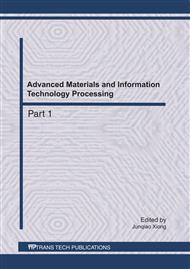[1]
Sheffi, Y., 1990. Third party logistics: present and future prospects. Journal of Business Logistics 11 (2), 27–39.
Google Scholar
[2]
Min, H., Foo, S.F., 2006. Benchmarking the operational efficiency of third party logistics providers using data enveloped analysis. Supply Chain Management: an International Journal 11 (3), 259–265.
DOI: 10.1108/13598540610662167
Google Scholar
[3]
Langley, J., Capgemini, 2007. The state of logistics outsourcing: 2007 third-party logistics. In: 12th Annual study Study of Third Party Logistics". B. Simpson, et al, "Title of paper goes here if known, unpublished.
DOI: 10.1201/9781420004588.ch27
Google Scholar
[4]
Delfmann, W., Albers, S., Gehring, M., 2003. The impacts of electronic commerce on logistics service providers. International Journal of Physical Distribution & Logistics Management 32 (3), 203–222.
DOI: 10.1108/09600030210426539
Google Scholar
[5]
Berglund, M., Van Laarhoven, P., Sharman, G., Wandel, S., 1999. Third-party logistics: is there a future? International Journal of Logistics Management , 10 (1), 59–70.
DOI: 10.1108/09574099910805932
Google Scholar
[6]
Murphy, P.R., Daley, J.M., 2001. Profiling international freight forwarders: an update. International Journal of Physical Distribution and Logistics Management , 31 (3), 152–168.
DOI: 10.1108/09600030110389433
Google Scholar
[7]
Lai, K.H., Cheng, T.C.E., 2003. Supply chain performance in transport logistics: an assessment by service providers. International Journal of Logistics: Research and Applications 6 (3), 151–164.
DOI: 10.1080/367556031000123115
Google Scholar
[8]
Wernerfelt, B., 1984. A resource-based view of the firm. Strategic Management Journal 5 (2), 171–180.
Google Scholar
[9]
Hertz, S., Alfredsson, M., 2003. Strategic development of third party logistics providers. Industrial Marketing Management 32 (2), 139–149.
DOI: 10.1016/s0019-8501(02)00228-6
Google Scholar
[10]
Lai, K.H., Ngai, E.W.T., Cheng, T.C.E., 2002. Measures for evaluating supply chain performance in transport logistics. Transportation Research: Part E, Logistics and Transportation Review 38 (6), 439–456.
DOI: 10.1016/s1366-5545(02)00019-4
Google Scholar
[11]
Makadok, R., 2001. Toward a synthesis of the resource-based and dynamic-capability views of rent creation. Strategic Management Journal 22 (5), 387–401.
DOI: 10.1002/smj.158
Google Scholar
[12]
Sirmon, D.G., Hitt, M.A., Ireland, R.D., 2007. Managing firm resources in dynamic environments to create value: looking inside the black box. Academy of Management Review 32 (1), 273–292.
DOI: 10.5465/amr.2007.23466005
Google Scholar
[13]
Ray, G., Muhanna W.A., Barney, J.B., 2005. Information technology and the performance of the customer service process: a resource-based analysis. MIS Quarterly 29 (4), 625–652.
DOI: 10.2307/25148703
Google Scholar
[14]
Lewis, I., Talalayevsky, A., 2000. Third-party logistics: leverage information technology. Journal of Business Logistics 21 (2), 173–185.
Google Scholar
[15]
Zineldin, M., 2004. Total relationship and logistics management. International Journal of Physical Distribution & Logistics Management 34 (3/ 4), 286–301.
DOI: 10.1108/09600030410533592
Google Scholar
[16]
Karia, N., Razak, R.C., 2007. Logistics assets that payoff competitive advantage. In: Soliman, K.S. (Ed. ), Information Management in the Networked Economy: Issues & Solutions. International Business Information Management Association, New York, p.33.
Google Scholar
[17]
Hunt, S.D., 2001. Commentary: general theory of competition: issues, answers and an invitation. European Journal of Marketing 35 (5/6), 524–548.
DOI: 10.1108/03090560110388097
Google Scholar
[18]
Grant, R.M., 1996. Prospering in dynamically-competitive environment: organizational capability as knowledge integration. Organizational Science 7, 375–387.
DOI: 10.1287/orsc.7.4.375
Google Scholar
[19]
Min, S., Roath, A.S., Daugherty, P.J., Genchev, S.E., Chen, H., Arndt, A.D., Richey, R.G., 2005. Supply chain collaboration: what's happening?. The International Journal of Logistics Management 16 (2), 237–256.
DOI: 10.1108/09574090510634539
Google Scholar


